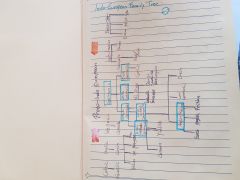![]()
![]()
![]()
Use LEFT and RIGHT arrow keys to navigate between flashcards;
Use UP and DOWN arrow keys to flip the card;
H to show hint;
A reads text to speech;
18 Cards in this Set
- Front
- Back
|
Indo-European familytree |

|
|
|
Germanic languages: |
English, Dutch,Icelandic, German, Yiddish, Frisian, Swedish, Danish, Norwegian, and Faroese.There is no earlier documented language. |
|
|
Germanic languages – Features Nr 1: |
(1) small number of tense and aspect distinctions of Proto-Germanic |
|
|
Germanic languages – Features Nr 2: |
(2) the presence of regular verbs (so-called weak verbs) with a {-d} or {-t} ending in the past (“dentalsuffix”/dentalstop) |
|
|
Germanic languages – Features Nr 3: |
(3) the presence of weak adjective endings |
|
|
Germanic languages – Features Nr 4: |
(4) the shift of word stress to the root syllable (First Germanic consonant shift) |
|
|
Germanic languages – Features Nr 5: |
(5) the presence of a fairly large number of wordswhich do not seem to be derived from IE sources |
|
|
Germanic languages – Features Nr 6: |
(6) and the effects of Grimm’s andVerner’s Laws. |
|
|
Grimm’s Law:
|
The first part of the Germanic Sound Shift which; describes the systematic shift in the way people pronounced certain consonants.
|
|
|
Grimm's Law (Detailed Answer) : |
The voiced stopes, the sounds /b/, /d/, and /g/,lost their voicing in Germanic and became /p/, /t/, and /k/. This means that IE /b/ represented by Latin lubricus underwent a change to/p/ as seen in English slippery. Likewise /d/ became /t/ as in the pair Latin ad and English at. Finally, /g/ as in jugum became/k/ as in yoke. This would have led to a merger with words that already had /p/, /t/, and /k/ except thelatter three themselves changes into the corresponding fricatives /f/, /θ/, and /h/. |
|
|
Verner’s Law: |
The Second part of the First Germanic Sound Shift contains what is known as Verner’s Law; points out the effect of word stress. |
|
|
Verner's Law (Detailed Answer) : |
According to Verner both pater and father originally carried their stress on the second syllable, as did IE phadēr. Verner discovered that voiceless fricatives (/f, s, θ, ʃ/) became voiced in Germanic if the preceding syllable was unstressed. |
|
|
Basic language external history (Germanic migrations): |
The speakers of the various Germanic languages stood, in a close relationship to the Roman Empire, which exercised a great deal of influence on the lives of the Germanic peoples, including borrowing into their languages. |
|
|
Pre-Old English (how loans transfered): |
The Romans took over some of the Celtic words which then became Roman loan words, which then became old Irish and which then became old English. |
|
|
Early Latin loans (Pre-Old English) : |
In further Latin borrowings (circa OE period) such as {portus} “harbour” (Portsmouth), {strata} “road, street” (Stratford), or {vīcus} “farm or village”. |
|
|
Early Latin loans (Direct borrowings) : |
Direct borrowings from Latin (and possibly Scandinavian) to OE: mile `mile´ L. Caupo > OE. Ceap > Cheap pil `spear´ . Mynet > OE. Myntt > “Coin” pytt `pit´ |
|
|
Case system: |
Case is a special grammatical category whose value reflects the grammatical function performed by a noun or pronoun in a phrase, clause, or sentence. |
|
|
OE: case system; |
Old English case system: Nominative (Agent/subject) Accusative (Patient/ “book”) Genitive (“possessive”) Dative (Indirect object/ “him”) Instrumental (Case/ manner ofaction/ “stone”) |

